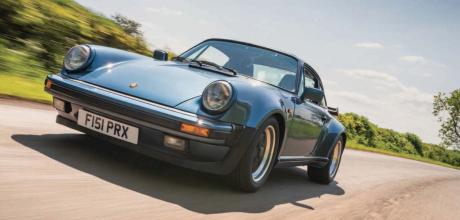1988 Porsche 911 Turbo 930
This former 911 Turbo press car has been given a new lease of life following two years spent in the workshops of Porsche indie, Mike Champion Engineering. We head to Oxfordshire and get behind the wheel...
Words Nicholas Found
Photography Dan Sherwood
RESTORED 911 TURBO PACKS EXTRA PUNCH AIR-COOLED CLASSIC PROMO STAR BACK IN THE SPOTLIGHT
FORMER 930 PRESS CAR TRIED & TESTED
TIME TRAVEL TURBO
Rediscovering a former 911 Turbo press car
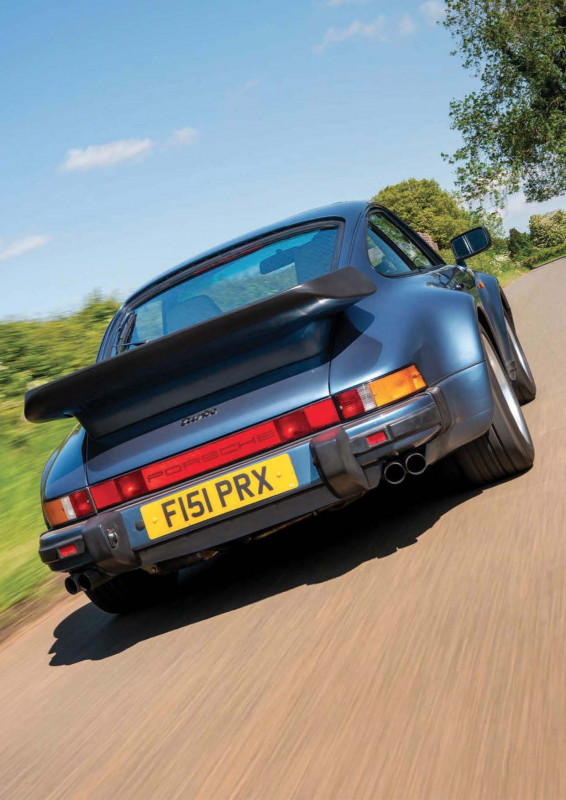
Time travel, so I thought, was the reserve of science fiction, but this late 1988 Porsche 911 Turbo (930) has proved me wrong. Fresh as the daisies springing up in the surrounding Oxfordshire countryside, the car has recently emerged from a two-year recommissioning and bodywork restoration process carried out by air-cooled Porsche specialist, Mike Champion Engineering (MCE). It’s a 911 that’s come full circle. A former Porsche Cars Great Britain demonstrator featured heavily in the pages of Autocar, Car and other motoring titles back in early 1989, this beautiful blue Turbo is once again in the hands of the press. And today really could be the late 1980s all over again — after hearing news of train strikes, a property market downturn and a cooling labour front, I switch on the radio and hear Cher’s If I Could Turn Back Time blasting out of my 997’s speakers as I make my way to MCE’s base near Banbury.
WHAT BECOMES CLEAR QUITE QUICKLY IS HOW IT PAYS TO THINK CAREFULLY ABOUT THROTTLE INPUTS AND REVS BEFORE ENTERING A CORNER
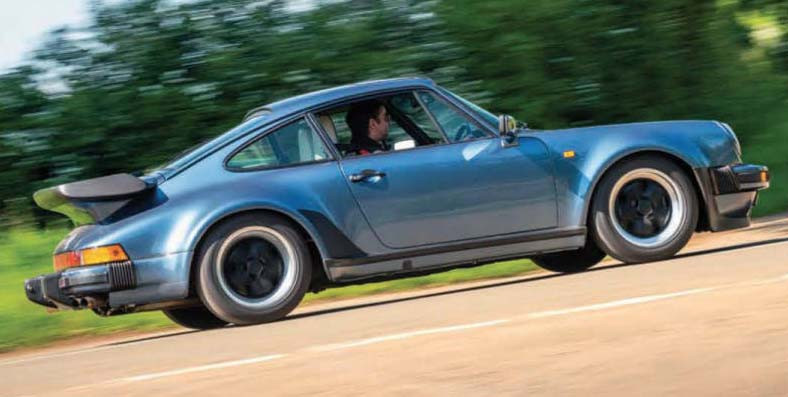
This force-fed 911 has covered just ten miles since completion of the restoration, giving me a unique opportunity to understand just how this former Porsche flagship would have felt when new. It’s a privilege and, I have to say, quite surreal — I’m experiencing what noted journalists, David Vivian, Roger Bell and Gavin Green, felt more than three decades ago in this very car. Back then, it donned Porsche Cars Great Britain’s famous 911 HUL number plate, reserved for top-tier examples of 911 Turbo and, latterly, Turbo S press cars. First used on an early 930 in 1975, it has since been attached to every subsequent generation of 911 loaded with forced induction.
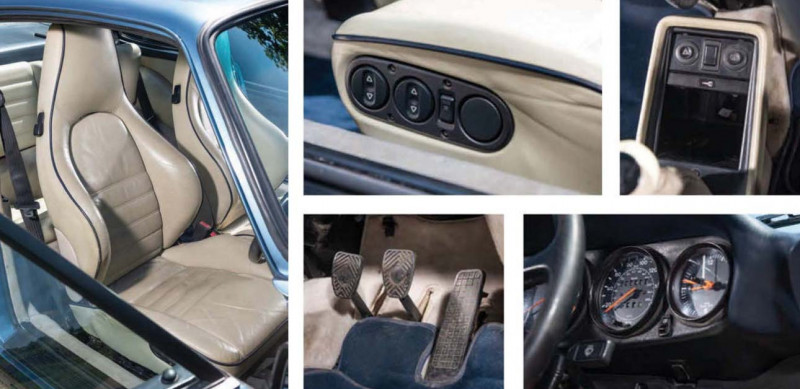
Make no mistake, this car is the stuff of legend. It came from a time when Turbo did what it said on the tin (or steel). It signalled the presence of a turbocharged engine, rather than premium trim level, something the badge has come to represent today, best illustrated by its use on the decidedly non-turbocharged all-electric Taycan. It’s somewhat ironic how the tables have turned — back in the 1980s, Turbo was used as a byword for anything remotely exciting. It came to be used in branding for a wide variety of products, from cars to aftershave to sunglasses. Of course, even in the decade of ‘greed is good’, turbocharging for production cars was still in its relatively early stages of development, but there’s no denying it was exciting.
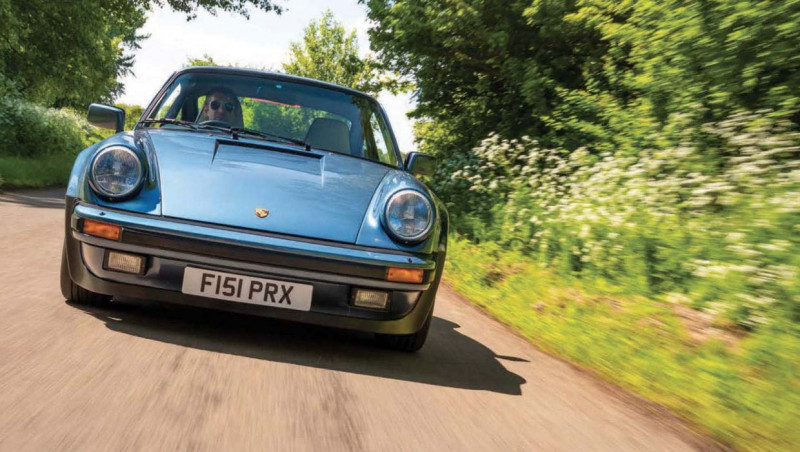
Porsche dabbled with turbocharging at the race track in the late 1960s, before applying it to the original 911 Turbo in 1975. Developed as a homologation special in recognition of then new motorsport regulations, the 930 was Porsche’s way of qualifying the Group 4 934 and Group 5 935 for racing in 1976. Sales were expected to hover around four hundred units, but by the end of the 930’s fourteen-year production, 18,770 examples had rolled off the production line. Around 1,500 911 Turbos were manufactured for the 1989 model year, with two fifths of this number heading to the US market, making a late 930 a rare sight in the UK, both then and now.
Although little changed in the model’s overall development from the late 1970s to the close of the following decade, a gulf had opened between first-of-the-breed and the runout 911 Turbo of 1989. A ‘tea tray’ spoiler replaced the earlier ‘whale tail’ in order to house a larger intercooler, which helped take power from 256bhp to 296bhp and joined a flat-six lifted from three litres to 3.3. As power swelled, so too did weight (to the tune of two hundred kilograms).
These updates came as Porsche pitched the 930 to a more affluent customer wanting creature comforts, much like Ferrari had done with its Testarossa and Lotus with the Esprit. As a consequence, the 930 was less ‘pure’, but it now offered supercar performance with genuine grand touring abilities.
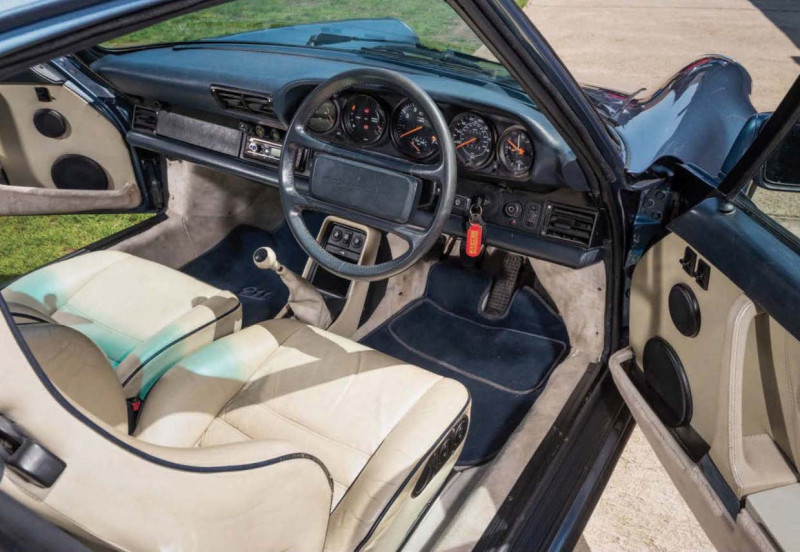
I JUST HAVE TO REMEMBER TO TUCK MY LEFT FOOT UNDER THE CLUTCH PEDAL TO GET COMFORTABLE
As a last hurrah before retirement of the G-series platform in favour of the 964, the final year of 930 production saw the introduction of the Getrag G50 transmission, adding a fifth gear. The Carrera 3.2 had been making use of this gearbox for some time, not that the four-speed 915 particularly bothered Mike Ormond, owner of our glistening feature car. His first Porsche was a Carrera RS 2.7 Lightweight, sold when the car was worth a fraction of its current value. Later, he acquired a Sportomatic-equipped 911 T, which he ended up transforming into an RS Lightweight homage packing a 3.2-litre motor. The car was sold twenty-five years ago to fund a career change.
IN THE PINK
He bought his 930 in 2009. It takes up residence in an eclectic collection of classics, including a Lotus Seven (thirty years in the making), a Sebring Sprite, a Frazer Nash and a string of fifteen motorbikes. The provenance-packing Porsche is his choice for European road trips, taking in bucket list destinations, such as Monaco, the Mille Miglia and Angouleme Circuit Des Remparts.
Restoration and motorsport specialist, Tuthill Porsche, rebuilt the engine around eleven thousand miles ago. It became “ropey”, to use Ormond’s description. A few years after the work was finished, the car was laid up for half a decade while he focused on his renovating his house. Leaving the Porsche unattended for so long did it no favours — corrosion began to set in. General recommissioning became increasingly urgent.
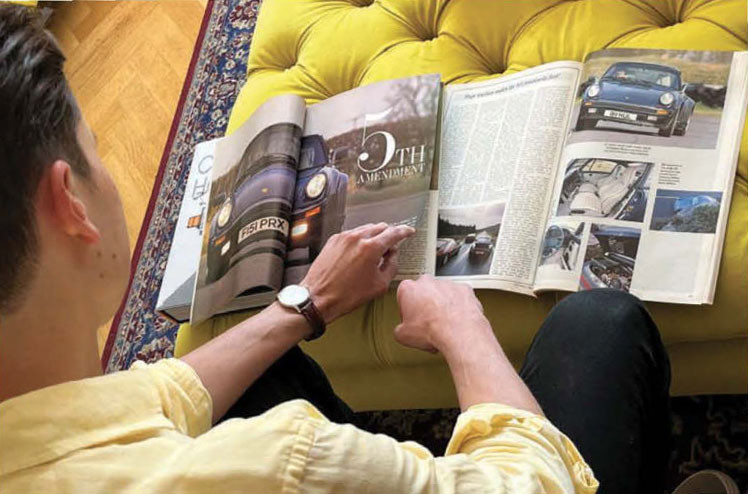
At this point, Ormond discovered MCE. The company is one of few carrying out end-to-end restorations of air-cooled Porsches in-house. An engineer by trade, company founder, Mike Champion, has developed a wide-ranging set of skills acquired over a long career working not only in the field of bodywork repair, but also during time spent at Tom Walkinshaw Racing (TWR), helping to develop the Renault Clio V6. After time served at TWR, he spent three years working on engine development at Jaguar, before joining Cosworth, where he stayed for seven years, developing variable valve timing concepts and managing race engine programmes for industry clients, including Aston Martin. He was then invited to work for the Gaydon concern directly, before being pulled back to Jaguar to oversee complex chassis and suspension design projects, as well as complete vehicle testing. Where he’s found time to build a street-legal Jägermeister-liveried Carrera RSR 3.0 replica to compete in the Porsche Club Great Britain’s 911 Challenge series, I’ll never know. Due to Ormond wanting his 930 left in the custody of a specialist who would have intimate knowledge of the entire car, MCE was an obvious choice. As is typical of air-cooled 911s, a strip down of the bodywork saw inners wings, kidney bowls, sills and C-pillars cut out and replaced. Factory-pressed repair sections from Porsche were used throughout, with MCE’s fabricated sheet sections adopted where appropriate.
The corrective bodywork, however, didn’t stop at dealing with tin worm. This 930 has covered 87,000 miles. Given the model’s reputation for being unruly in the hands of those with a lead foot and not much experience of 911 chassis dynamics, it probably doesn’t surprise you to learn Ormond’s car became acquainted with a hedge at some point in its life (before his ownership). Not that you’d ever know it today — MCE has done a fantastic job of correcting past repairs to a standard and finish you’d expect from factory. Every bolt I can see is new, plated or painted. Not that parts have been needlessly replaced for the sake of restoration. Champion’s approach is to be sympathetic to whichever Porsche he’s working on, retaining originality wherever possible.
Having sat for a while, the car needed a full overhaul of its brakes, suspension and cooling equipment, as well as replacement sill pipework and elimination of electrical gremlins. All replacement parts were supplied by Porsche. Pleasingly, the interior has been preserved, as evidenced by a door card lovingly repaired to maintain originality.
BACK IN FRONT
Seldom do former Porsche press cars resurface — their true history is often lost at the point the vehicle passes into private ownership following time spent in the main dealer network. Even so, this isn’t the first Porsche press demonstrator recommissioned by MCE. Indeed, Champion recently resurrected an early 1965 912. Finished in Light Ivory, not only is this four-cylinder ‘baby 911’ one of the first three right-hand-drive 912s produced, but it served as a press demonstrator for Porsche’s British sales outpost, AFN, when new. Porsche press cars need a particular level of sensitivity and knowledge to restore. For example, what may at first appear to be an incorrect part, could well be specially optioned equipment installed at the instruction of Porsche to wow motoring journalists. Expect anything from thicker carpets to tweaked suspension, bigger brakes, uprated audio equipment and, of course, bespoke colours. It was Tuthill’s Paul Green who spotted something unusual when rebuilding this 930’s engine. Upon removing a cracked wastegate, which normally opens at a preset of near 0.7 bar (controlled by a mechanical spring), he found a spacer had been used as a savvy way to prolong time the wastegate stays closed, allowing boost pressure to build beyond 0.7 bar. I’m not claiming Porsche planted this part in order to improve the car’s performance during road tests, but as far as anyone can tell, the item was original to the car. I intentionally refer to this modification in past tense — beyond the point of repair, the old wastegate was replaced for a unit made by EBS Racing in California, reliably increasing boost pressure to 1.0 bar, enabling the engine to produce approximately 360bhp, around twenty percent more power than standard.
HIS FIRST PORSCHE WAS A CARRERA RS 2.7 LIGHTWEIGHT, SOLD WHEN THE CAR WAS WORTH A FRACTION OF ITS CURRENT VALUE
After all this restoration work, what is Ormond’s 911 Turbo like from behind the wheel? As I reach for the door handle to step in, I immediately want to close and open the door again and again. The mechanism is just about the best of any car I’ve come across. Like a good handshake, the handle is cool to touch, direct and solid, making me all too aware of the fact modern 911s have lost this important first impression.
This first touch immediately gives a sense of the car’s overall quality. It’s a reassurance needed as I ponder what on earth is going on with the dashboard layout. It isn’t unique to the 930, but it’s made worse in later examples because more buttons were added (with no apparent logic) to an aging dash layout. The switch to open the sunroof on this warm day is somewhere hidden by my knee. The push button to lock the doors is buried in the centre console. The rotary dial to unlock is positioned on the door card. It’s mad. Perhaps it made more sense to the hazy-eyed 911 Turbo driver of the 1980s?
What does make perfect sense to me are the seats. They’re plush, but pinch you around the kidneys, as they should in a sports car. These wide-bolstered ‘tombstones’ make the large, almost bus-like steering wheel feel out of place. Incidentally, this 930 made use of an aftermarket MOMO steering wheel when Ormond bought the car, but he switched back to the original item in the interests of correctness.
Obviously, what you do with a steering wheel matters more than its design. As I pull away from MCE and thread through local towns and villages, I’m immediately struck by the fact this is a demanding 911 to drive. Looking at its small footprint may make you think the car is light on in its toes, but it’s a physically demanding Porsche and requires heft with almost every input.
Let’s start with the steering. Having no power assistance, it’s heavy at slow speed. To counter this, I head out of town to an A- or B-road. Get above 60mph, and the steering lightens up as the front end begins to lift. It’s not alarming or wayward, but it’s a reminder of where the weight is in a 911 and feels in complete contrast to modern 911s, which come complete with variable power assistance, light at low speed and weighting up as you gather pace. Then there’s pedal placement. Anyone who hasn’t owned an air-cooled 911 or a Volkswagen Beetle will find the floor-mounted pedals alien. The clutch isn’t so much heavy as it is straining. In period, the hydraulic system for the G50 was criticised for being too heavy. As I depress the clutch, I find my heel lifting off the floor as the pedal moves in a rather unnatural arc.
In a right-hand drive 930, when the clutch pedal is released, there’s nowhere to put your left foot. In the past, I’ve owned cars where righthand drive pedal placement was an afterthought. I just have to remember to tuck my left foot under the clutch pedal to get comfortable. Lucky, then, I won’t need to exercise the clutch too much due to the gears being so tall. The G50 gearbox may have brought an extra gear, but make no mistake, the ratios are long. This is a car that’ll comfortably do 45mph in first gear and 78mph in second. By not having shorter ratios, many contemporary reviewers felt the G50 missed a trick over the four-speed.
In the real world, is this such a bad thing? It depends what part of the rev range you’re in. Below 3,000rpm, I’d forgive you for feeling short-changed — the long gearing and low compression of 7.0:1 exaggerate turbo lag off-boost. This is typical of early turbocharged cars. During the engine rebuild, Tuthill responded by installing cams from a 911 SC (the normally aspirated engine of which is derived from that of the original 911 Turbo) and upping compression ratio to 7.5:1. It certainly helps this 930’s mid-range torque, and the engine feels stronger because of it, but it’s like rearranging deckchairs on the Titanic. The lag remains.
It builds tension though, in the same way as pulling back on a sling shot before firing forward. Above 4,000rpm is where the curtains are pulled back and the on-boost theatrics start. The revs flare up like striking a match.
Any frustrations are quickly forgotten. Such is the step change and response, it’s as if someone bolted a lightweight flywheel to the engine without you knowing. At these moments, the long gearing helps me hold onto the revs as much as possible as I watch the boost gauge climb to 1.0 bar.
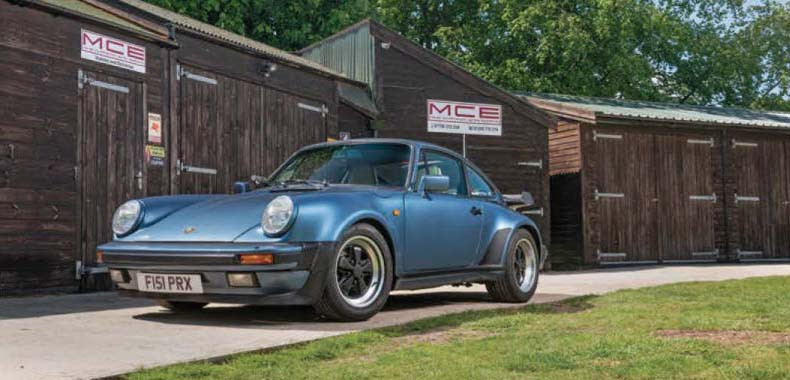
In many ways, the 930 can be likened to a knife. Until the turbocharger builds boost pressure, you’re effectively driving around in a butter knife. As the boost gauge climbs, however, the car sharpens into a steak knife. It’s easy to see how the wrong hands may draw blood, but manage the boost with your right foot and this car will carve through A-roads at a pace many modern 911s will struggle to keep up with. Just about the only thing on-boost moving faster than the speedometer is the fuel gauge. Nestled somewhere between farmland outside Banbury, the car spluttered as it chugged out of petrol. Granted, there are worse cars to be standing beside when stranded at the side of the road. As Champion went to fill a jerry can with premium unleaded, I took the opportunity to soak in the Baltic Blue metallic bodywork sprayed in Max Meyer two-stage paint. This colour often looks flat in photos, but in the day’s blazing sunshine, it pops enough to get the attention of a passing gang of teenage cyclists.
The classic 911 Turbo’s no-nonsense presence has stood the test of time — the gang’s eyes are drawn like magnets to the Porsche, just as it would have commanded their attention in 1989. Sat on Fuchs alloys (refurbished in-house by MCE to the correct anodised and satin finish), the rear end looks pressed to the ground, unlike the bulbous behinds of today’s rather large 911s.
A can of fuel later and the 930 fires back to life. Surrounded by stunning B-roads, I try to dial into the chassis a bit more. Even after miles of twisting stretches, this car takes time to build a rhythm with. The chassis wriggles and rolls as it moves about on those 55-profile Pirelli front tyres and OEM Bilstein dampers. What becomes clear quite quickly is how it pays to think carefully about throttle inputs and revs before entering a corner. I dare not push the accelerator pedal all the way to the floor unless the car is arrow straight. Turbo lag makes it difficult to ever get on the power early, but it’s easy to picture how a surge of boost with a bit of lock could unsettle the chassis.
After all, the 930 generates a lot of power in a short powerband, and let’s not forget this is a Porsche running rather rudimentary suspension with torsion bars. Tweaks were made for the 1989 model year, such as larger torsion beams and a smaller front anti-roll bar, but there’s no getting away from roots that stretch back decades.
This 911 doesn’t feel designed to oversteer, though. There’s a lot of weight and traction over the rear, which means the nose wants to wash wide, if anything. The front-end needs locking into a corner for me to be able to utilise the rear traction on offer.
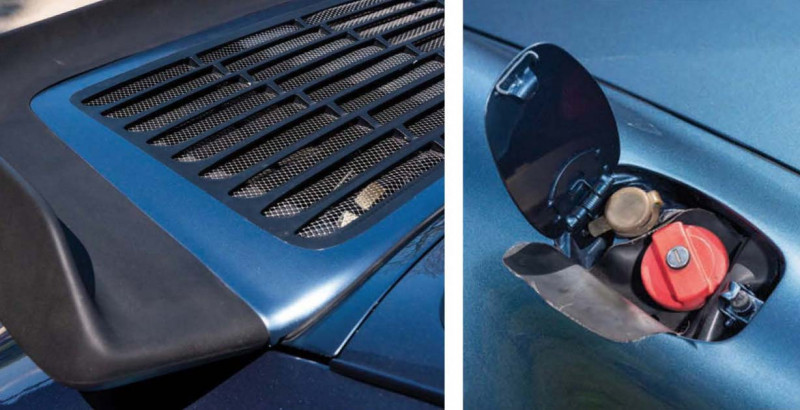
Luckily, the brakes are impressive, steadying pace into corners. There’s no excuse for them not being good, considering the package comprises aluminium calipers loaded with drilled discs and is derived from the 917 race car. The bite is positive, only distorted by pedal placement. The biggest risk is the lack of ABS forcing you to lock up the front if you want to come to a complete and sudden stop.
Heading back to MCE though a series of towns, there’s plenty to relish offboost. I even begin to enjoy flexing my muscles and weave through traffic. It beats a workout at the gym, anyway. Most of all, I soak in the bellowing sound from the custom stainless steel exhaust, which for Ormond, proved to be a blast from the past in every sense — he used to be a tutor, and a former student of his (who he hadn’t seen for forty years) was responsible for constructing the system at RS Fabrications in Towcester. The pipework pops confidently on overrun and adds tone to the engine without being obnoxiously loud.
Pulling into MCE’s workshop to hand back this 911’s keys, I immediately want to drive it all over again. Unlike so many of today’s sports cars, this isn’t a one-trick pony. It’s a multi-layered driving experience taking time to adjust to. Consequently, it’s not a car you can jump in, point, and shoot, as you might in a modern 911 Turbo. You need to get to know a 930, much like a vintage whisky. Drink too much too soon, and it’ll hit hard and slur you about. Soak it in, however, and you’ll be able to enjoy all the undertones and punch on offer.
The 930 is unrepeatable. Its ergonomics, handling and power delivery take you back to a moment in time from decades past. As cars become more homogeneous and electrified, this Turbo will only become more interesting. It’s from a bygone era, but one you’ll want to keep revisiting.
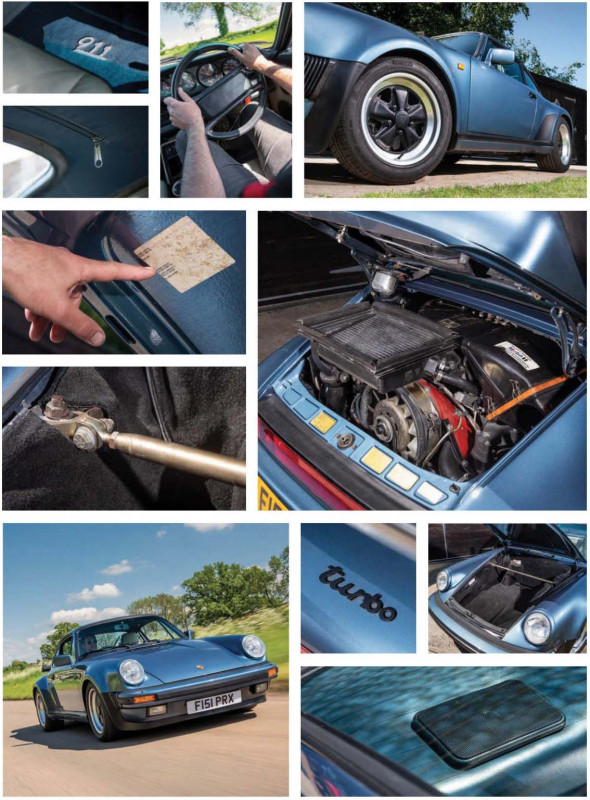
Above and facing page Modifications to the flat-six has seen power increase by approximately twenty percent over stock. Below Sitting pretty outside the MCE workshops near the historic market town of Banbury.
Below Exhaust system was built by RS Fabrications in Towcester and gives the Tuthill-built flat-six a superb soundtrack.
Above While the 911’s seats evolved over time, the dash layout moved on very little between the 901 of 1963 and discontinuation of the 993 in 1998, causing Porsche’s designers to fit buttons for new electrical equipment wherever they could find space to do so.
Above Unrestored, the cabin carries the patina many classic Porsche enthusiasts hold in high regard.
Below This 930 isn’t the first Porsche Cars Great Britain press car MCE has restored.
Above MCE has worked through the car, restoring bodywork and repairing the interior.
Below When new, the car appeared in the pages of many magazines, including Autocar and Car.
Facing page Formerly a Porsche Cars Great Britain press car, this Baltic Blue 930 originally wore the firm’s famous 911 HUL registration


